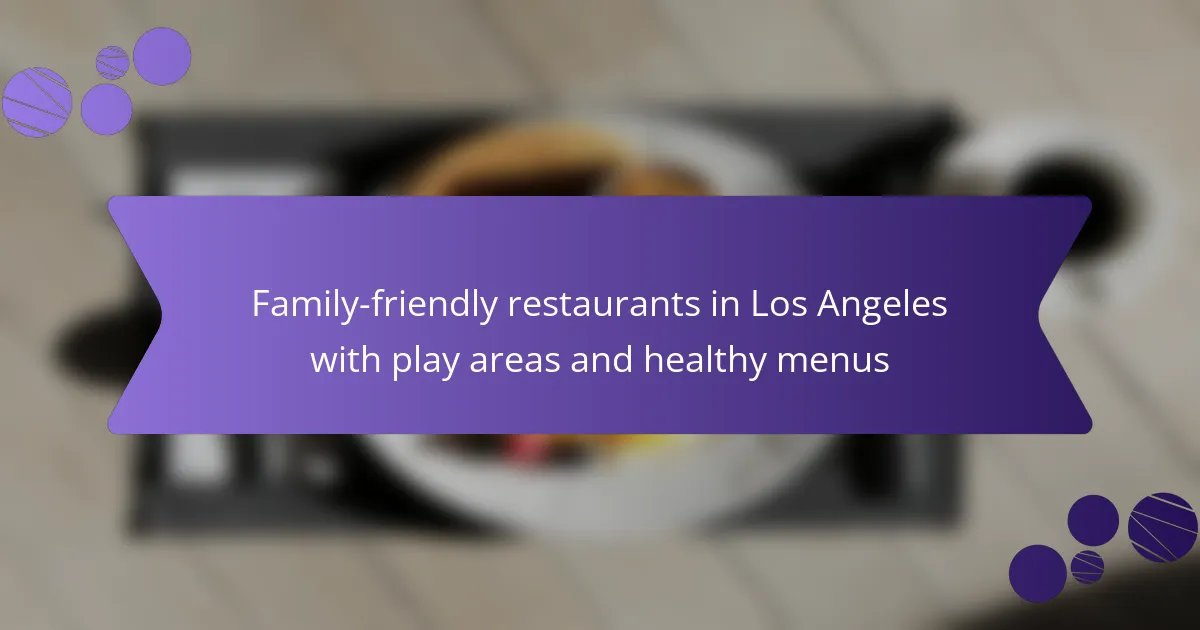
What are family-friendly restaurants in Los Angeles with play areas and healthy menus?
Some family-friendly restaurants in Los Angeles with play areas and healthy menus include The Kid’s Table, which offers a variety of nutritious options and a play space for children. Another option is The Grove’s Farmers Market, featuring healthy food stalls and outdoor seating with a play area. Additionally, The Playroom at The Santa Monica Place provides a menu focused on wholesome ingredients alongside a dedicated play area. These establishments cater to families seeking both a healthy dining experience and a fun environment for kids.
How do these restaurants cater to families?
Family-friendly restaurants in Los Angeles cater to families by providing play areas and healthy menu options. These establishments often feature designated play zones to keep children entertained. This allows parents to enjoy their meals while children engage in safe activities. Additionally, many restaurants offer children’s menus that include nutritious choices. These menus are designed to appeal to kids while meeting health guidelines. Many family-friendly restaurants also provide high chairs and booster seats for younger children. Some locations host family-oriented events or activities on weekends. These features create a welcoming atmosphere for families dining out.
What features make a restaurant family-friendly?
A family-friendly restaurant offers features that cater to both children and parents. These features include a diverse children’s menu with healthy options. Restaurants often provide high chairs and booster seats for younger guests. A safe, clean play area is essential for children to engage in activities. Staff who are patient and accommodating enhance the family dining experience. Some restaurants may also host family-oriented events or activities. Kid-friendly entertainment, such as coloring sheets or games, is often available. Flexible dining hours accommodate families with varying schedules. These features collectively create a welcoming environment for families.
How do play areas enhance the dining experience for families?
Play areas enhance the dining experience for families by providing a space for children to engage in play while parents enjoy their meals. This setup allows parents to relax without the constant need to entertain their children. Research indicates that restaurants with play areas can increase family visits by up to 30%. Children are more likely to behave well when they have a designated area to expend energy. Additionally, families often spend more time and money in establishments that cater to children’s needs. Play areas can also foster social interactions among children, creating a more enjoyable atmosphere for families. Overall, these spaces contribute to a more pleasant dining experience for both parents and children.
Why is a healthy menu important for family-friendly restaurants?
A healthy menu is important for family-friendly restaurants because it promotes better nutrition for children and families. Healthy options support the overall well-being of diners. Research indicates that children who consume nutritious meals are more likely to develop healthy eating habits. According to the Centers for Disease Control and Prevention, healthy diets can reduce the risk of obesity and chronic diseases. Additionally, offering healthy choices can attract health-conscious parents. This can enhance customer loyalty and satisfaction. Family-friendly restaurants can differentiate themselves in a competitive market by prioritizing health. Overall, a healthy menu aligns with the values of many families seeking nutritious dining options.
What types of healthy options are typically available?
Healthy options typically available at family-friendly restaurants include salads, grilled proteins, and whole grain dishes. Salads often feature fresh vegetables, lean meats, and light dressings. Grilled proteins such as chicken, fish, or tofu provide nutritious meal choices. Whole grain dishes, like brown rice or whole wheat pasta, offer fiber and essential nutrients. Many restaurants also provide kid-friendly options like fruit cups and vegetable sticks. These selections cater to health-conscious families seeking nutritious meals. The availability of these options supports dietary preferences and promotes better eating habits among children.
How do healthy menus impact children’s eating habits?
Healthy menus positively influence children’s eating habits by encouraging the consumption of nutritious foods. When children are presented with appealing and healthy options, they are more likely to choose fruits, vegetables, and whole grains. Research indicates that children exposed to healthier food choices develop better eating patterns over time. A study published in the journal “Appetite” found that children who frequently consume meals from healthy menus show a decreased preference for sugary and fatty foods. Additionally, family-friendly restaurants that provide engaging play areas alongside healthy options create a supportive environment for positive eating behaviors. This combination fosters healthier habits and encourages children to make better food choices.

What are the benefits of dining at family-friendly restaurants with play areas?
Dining at family-friendly restaurants with play areas offers multiple benefits. These establishments provide a safe space for children to play while parents enjoy their meals. This arrangement reduces stress for parents, allowing them to relax and socialize. Children are more likely to eat well when they have an outlet for their energy. Play areas can also encourage family bonding through shared experiences. According to a study by the National Restaurant Association, 70% of families prefer dining out when children can engage in fun activities. This preference can lead to increased customer loyalty for these restaurants. Overall, dining at such venues enhances the dining experience for families.
How do these restaurants support family bonding?
Family-friendly restaurants in Los Angeles support family bonding by providing engaging environments for shared experiences. They often feature play areas that allow children to interact and play together. This encourages families to spend quality time while children are entertained. Healthy menus promote shared meals that foster communication and connection. Dining together over nutritious food can enhance family discussions and relationships. Additionally, these restaurants often host family-oriented events that create memorable experiences. The combination of play, healthy eating, and social activities strengthens family ties.
In what ways do play areas promote interaction among family members?
Play areas promote interaction among family members by providing a shared space for activities. These areas encourage cooperative play, which fosters communication and teamwork. Parents and children can engage in games that require collaboration. This interaction strengthens family bonds through shared experiences. Play areas also facilitate informal conversations during play. They create opportunities for parents to observe their children’s social skills. Engaging in physical activities together can enhance family dynamics. Research indicates that play enhances family cohesion and satisfaction.
What role does a relaxed dining environment play in family meals?
A relaxed dining environment fosters positive interactions during family meals. It encourages open communication among family members. In such settings, families feel more comfortable sharing thoughts and experiences. This contributes to stronger emotional bonds. Research shows that family meals in relaxed atmospheres lead to better mental health outcomes for children. A study by the American Psychological Association found that children who regularly engage in family meals experience lower levels of stress. Additionally, relaxed environments can enhance the enjoyment of healthy food choices. Families are more likely to try new dishes when they feel at ease. Overall, a relaxed dining environment is essential for nurturing family relationships during meals.
What health benefits can families gain from healthy menus?
Families can gain numerous health benefits from healthy menus. Healthy menus often include nutrient-dense foods. These foods provide essential vitamins and minerals. Improved energy levels result from balanced meals. Healthy eating can reduce the risk of chronic diseases. Families may experience better weight management through healthier choices. Additionally, healthy menus promote better digestion and gut health. Studies show that children who eat nutritious meals perform better academically. Overall, healthy menus contribute to enhanced family well-being.
How do nutritious meals contribute to children’s growth and development?
Nutritious meals are essential for children’s growth and development. They provide the necessary vitamins, minerals, and energy required for physical and cognitive development. For instance, protein supports muscle growth, while calcium is crucial for strong bones. Nutrients like iron are vital for brain development and cognitive function. A balanced diet can enhance concentration and learning abilities. According to the World Health Organization, proper nutrition in childhood can lead to improved health outcomes later in life. Additionally, studies show that well-nourished children perform better academically and socially.
What are the long-term benefits of choosing healthy dining options?
Choosing healthy dining options leads to long-term benefits such as improved overall health and reduced risk of chronic diseases. Healthy meals typically contain essential nutrients, which support bodily functions. Regular consumption of nutritious foods can enhance energy levels and improve mental clarity. Additionally, a balanced diet is linked to a lower incidence of obesity. According to the CDC, maintaining a healthy weight can decrease the likelihood of heart disease and diabetes. Furthermore, healthy eating habits can foster better digestion and gut health. Research indicates that good nutrition contributes to longevity and quality of life. Adopting healthy dining choices also sets a positive example for children, promoting lifelong healthy habits.

How can families find the best family-friendly restaurants in Los Angeles?
Families can find the best family-friendly restaurants in Los Angeles by researching online reviews and restaurant directories. Websites like Yelp and TripAdvisor provide user-generated ratings and comments. Families should look for restaurants that specifically mention play areas and healthy menus. Social media platforms can also offer insights through local parenting groups. Visiting restaurant websites can reveal their amenities and menu options. Additionally, local food blogs often highlight family-friendly dining spots. Checking for kid-friendly features, such as children’s menus and activities, is essential. Word-of-mouth recommendations from friends and family can also be valuable. These methods ensure families discover suitable dining options that meet their needs.
What resources are available for locating these restaurants?
Online restaurant directories are available for locating family-friendly restaurants in Los Angeles. Websites like Yelp and TripAdvisor provide user reviews and ratings. Google Maps allows users to search for restaurants based on specific criteria. Social media platforms like Facebook feature local dining groups. Food blogs often review and recommend family-oriented dining options. Local parenting websites may also list suitable restaurants. Mobile apps can help filter restaurants by amenities and menu options. These resources collectively assist in finding restaurants with play areas and healthy menus.
How do online reviews influence restaurant selection?
Online reviews significantly influence restaurant selection by shaping consumer perceptions and decisions. Potential diners often rely on reviews to gauge food quality, service, and ambiance. A study by BrightLocal found that 82% of consumers read online reviews for local businesses. Positive reviews can enhance a restaurant’s reputation and attract more customers. Conversely, negative reviews can deter potential patrons. The visibility of reviews on platforms like Yelp and Google further amplifies their impact. In family-friendly contexts, reviews highlighting kid-friendly features can be particularly persuasive. Therefore, online reviews serve as critical decision-making tools for restaurant selection.
What role do social media and local guides play in discovering family-friendly dining?
Social media and local guides significantly aid in discovering family-friendly dining options. They provide user-generated reviews and recommendations. Platforms like Instagram and Facebook showcase photos of meals and restaurant environments. This visual content helps families evaluate suitability for children. Local guides often curate lists of family-friendly restaurants. They highlight features such as play areas and healthy menu options. According to a survey by the National Restaurant Association, 70% of families use online resources for dining decisions. This indicates the reliance on social media and guides for informed choices.
What tips can families use to enhance their dining experience at these restaurants?
Families can enhance their dining experience at family-friendly restaurants by planning ahead. Choose restaurants with play areas to keep children engaged. Review the menu online to select healthy options in advance. Arrive during off-peak hours to avoid long wait times. Bring activities or toys to entertain kids while waiting. Consider sharing dishes to try a variety of healthy foods. Request kid-friendly portions to minimize food waste. Engage with staff for recommendations on family-friendly options. These strategies can lead to a more enjoyable dining experience for everyone involved.
How can parents encourage healthy eating habits while dining out?
Parents can encourage healthy eating habits while dining out by choosing restaurants with nutritious options. They should review menus in advance to identify healthy meals. Opting for dishes that include vegetables, whole grains, and lean proteins is beneficial. Parents can also share meals to promote portion control. Encouraging children to drink water instead of sugary beverages is important. Setting a positive example by choosing healthy items themselves can influence kids’ choices. Engaging children in the decision-making process fosters interest in healthy foods. Research shows that children are more likely to try new foods when involved in meal selection.
What strategies can families employ to make the most of play areas during their visit?
Families can employ several strategies to maximize their experience in play areas during visits. First, arriving early allows families to enjoy less crowded spaces. This increases safety and access to play equipment. Second, families should set clear rules for children regarding play area behavior. This promotes respect and safety among kids. Third, parents can engage in play with their children. This enhances bonding and encourages active participation. Fourth, families should bring snacks and water to keep energy levels up. Staying hydrated and nourished is essential for active play. Fifth, planning playtime around meal times can ensure that children are not too hungry or tired. This leads to a more enjoyable experience. Lastly, monitoring children closely while they play is crucial for safety. Active supervision helps prevent accidents and ensures children are safe. These strategies collectively enhance the enjoyment and safety of play areas for families.
Family-friendly restaurants in Los Angeles with play areas and healthy menus provide a welcoming dining experience for families. These establishments, such as The Kid’s Table and The Grove’s Farmers Market, offer nutritious food options alongside designated play areas for children, enhancing both enjoyment and convenience for parents. The article explores how these restaurants cater to families through features like children’s menus, safe play environments, and events, while also highlighting the importance of healthy eating habits for children’s growth and development. Additionally, it discusses resources for locating these dining options and strategies for maximizing the dining experience.




